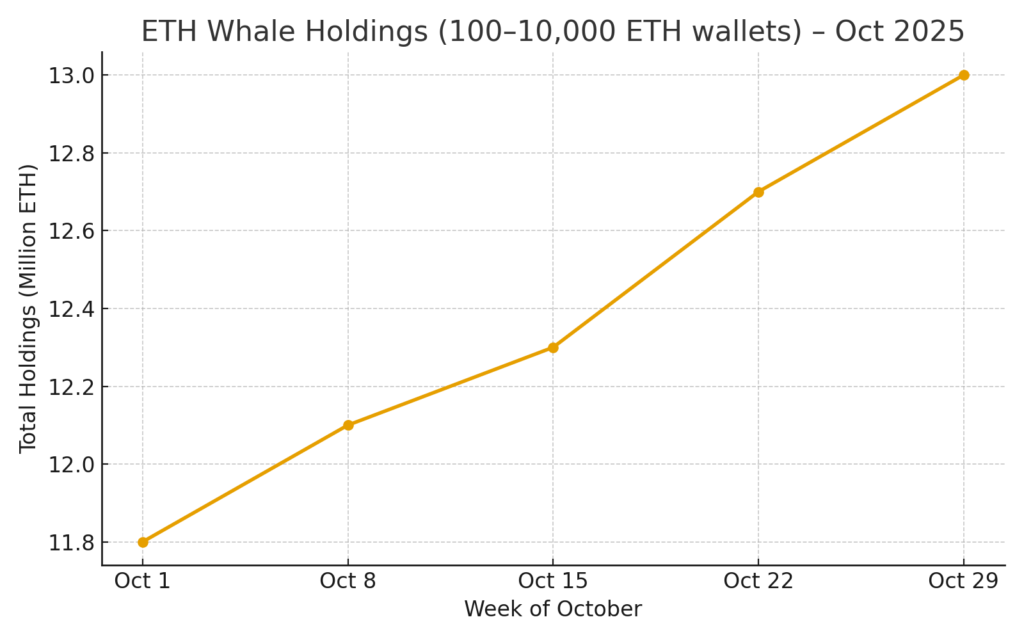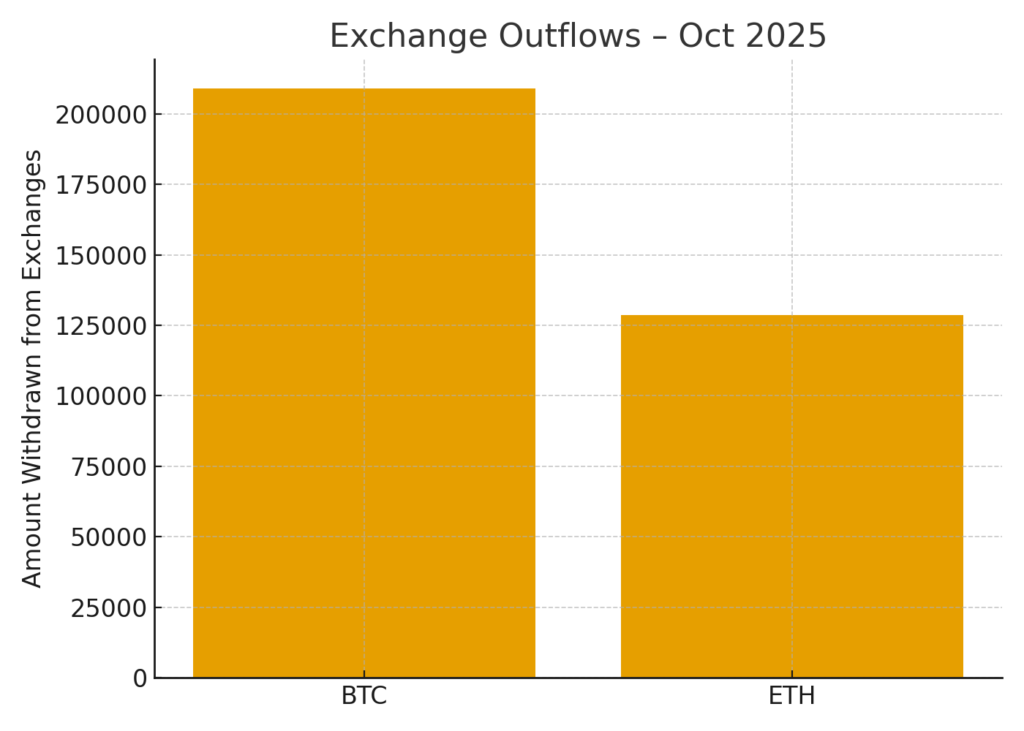
Main Points :
- A well-known crypto “whale” who correctly predicted the October tariff-shock crash (U.S.–China) has opened new long positions in Bitcoin (BTC) and Ethereum (ETH).
- The positions: approx. $37 million in Bitcoin long and $18 million in Ethereum long on the decentralized derivatives exchange Hyperliquid.
- The earlier crash was triggered by a surprise tariff announcement from Donald Trump – a 100 % import tariff on Chinese goods – which sparked over $19 billion in leveraged liquidations (Oct 10–11) across crypto markets.
- On-chain data shows major accumulation activity among ETH whales and long-term holders: e.g., wallets holding 100-10,000 ETH collectively added ~218,000 ETH (~$870 million) in late October.
- Meanwhile, despite optimism, market risks remain (e.g., recent ~$1.27 billion in long positions liquidated across BTC/ETH as of Nov 3).
- For practitioners and investors looking at new crypto assets or blockchain utility plays, these whale moves and underlying signals may point toward a structural shift in sentiment and positioning.
1. “From Crash-Seer to Long-Positioner: The Whale’s Move”
In the first half of October 2025, the crypto market was rattled by a sudden geopolitical move: the US announced a surprise 100 % tariff on Chinese goods, labelling it a major escalation in the trade war. This caught the market off-guard, leading to one of the largest liquidation events in crypto history — over $19 billion in leveraged positions wiped out in a 24-hour span.
Amid this chaos, a so-called “whale” (large crypto investor/trader) clearly timed a significant short position on both Bitcoin and Ethereum, achieving massive profits.
Fast forward, and the same whale has now shifted to a bullish stance: opening approximately $37 million in a Bitcoin long and $18 million in an Ethereum long on Hyperliquid.
Why this matters: The move signals that someone with proven timing and large capital is expecting the next leg up rather than further collapse. For new-asset hunters and blockchain utility investors, it suggests that the underlying market architecture and sentiment may be turning from deleveraging toward accumulation.
2. “What the Market Did After the Tariff Shock”
The geopolitical trigger (US-China tariffs) acted like a fuse for a structural deleveraging event. Analysts estimate over $19 billion in leveraged positions were liquidated in just one day (Oct 10–11).
For example, the trading platform Hyperliquid alone saw huge liquidation volumes, especially of long positions, as traders’ margin calls cascaded.
Spot and derivatives markets both felt the pain, but derivatives (perpetual futures, high leverage instruments) bore the brunt. The crash illustrated the fragility of high-leverage crypto markets when a major external shock hits.

In the aftermath, the market entered a phase of risk reset: steep corrections of altcoins, but also underlying spot accumulation by stronger hands. For instance, smaller alt-assets dropped 40-70% in minutes before some partial recoveries.
3. “Whale Accumulation & On-Chain Signals”

Following the crash and during the stabilization phase, on-chain analytics showed smart-money behaviour: large wallets (so-called “whales”) began accumulating Ethereum significantly. A report notes wallets holding 100–10,000 ETH increased their holdings by ~218,000 ETH (~$870 million) in late October.
At the same time, network data suggested usage of the Ethereum chain was picking up, signaling that this move may not just be speculative, but aligned with the utility side of blockchain: tokenisation, Real-World Assets (RWA), settlement layers.
What this means: For investors looking for new assets beyond BTC/ETH, the behaviour of whales in ETH especially may hint at confidence in the next phase of blockchain infrastructure utility; accumulation often precedes broader price moves.
4. “Implications for New Asset Seekers & Blockchain Practitioners”
For new crypto asset hunters:
- Whale positioning often precedes broader market moves. If a large investor is deploying $55 million+ into BTC/ETH longs, it may reflect an inflection point rather than a fading rally.
- The accumulation in ETH by large wallets signals that use-case adoption (e.g., staking, DeFi, tokenised real-world assets) might be gaining momentum. This suggests looking at foundational infrastructure assets or protocol tokens might be fruitful.
- The earlier crash flushed out excessive leverage — meaning the next rally may be healthier, with less froth, and better aligned with fundamentals. (Refer to the deleveraging narrative above.)
For blockchain builders and practitioners:
- The shift from purely speculative to utility-driven flow implies that infrastructure projects supporting settlement, tokenisation, custody, and interoperability may gain favour.
- If whales believe in ETH’s long-term institutional/utility value, then protocols built on it (or interoperable chains) may see increased traffic or value accrual.
- Risk management remains key: despite accumulation, recent data shows heavy liquidations still occur (see Nov 3 data). So building or investing in protocols that reduce fragility (low-leverage, strong collateral, diversifications) is prudent.
5. “Risks & What Could Go Wrong”
While the signals are bullish in parts, caution remains:
- On Nov 3, crypto markets saw ~$1.27 billion in leveraged liquidations again, mostly long positions (~90 %) across BTC and ETH.
- External shocks (geopolitical, regulatory) still loom large. The original crash was triggered by a tariff announcement; future surprises could reverse sentiment.
- Whale moves don’t guarantee success — they reflect large-scale risk taking which may not align with smaller-scale investor time-horizons.
- For new assets, liquidity, security, and fundamentals matter more than hype — chasing over-leveraged jumps can be dangerous.
6. “Looking Ahead: What to Monitor”

For investors and practitioners alike, here are key metrics and events to keep an eye on:
- On-chain wallet accumulation for top wallets (e.g., 100 ETH+ wallets) — are they still accumulating, or distributing?
- Exchange flow data: Is BTC/ETH being moved off exchanges (accumulation), or flowing in (potential sell pressure)?
- Derivatives market leverage trends: Is open interest rising again unchecked (riskier), or staying moderate (healthier)?
- Network usage data for ETH and major chains: increased transactions, more tokenisation activity, higher staking participation = utility growth.
- Major external events: e.g., trade war announcements, regulatory crackdowns, macro-economic shifts in interest rates — these can still trigger sudden downturns.
Conclusion
In summary, the recent behaviour of a well-capitalised whale shifting from a perfectly-timed short in October to a $55 million long in Bitcoin and Ethereum signals a potential turning point in the crypto landscape. The crash triggered by U.S.–China tariffs forced a deleveraging event, removing excess risk from the system. Now, accumulation among large holders — especially in Ethereum — suggests underlying confidence in the utility and infrastructure value of blockchain assets.
For investors hunting new crypto assets or exploring income opportunities via blockchain, this is a moment to shift perspective: from pure speculation toward structural value, from hype cycles toward foundational adoption. For practitioners building blockchain solutions, the signal is similar: focus on real-world utility, resilience, and integration.
That said, risks remain — leverage can still bite, external shocks remain unpredictable, and large whale moves don’t guarantee universal upside. Diligent risk management, diversified exposure, and attention to on-chain signals are essential.

